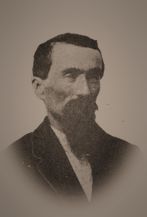June 21 — The enemy received reinforcements last night, and this morning we saw a transport laden with soldiers going up the river toward the White House.
About two hours after sunrise this morning the Yankees commenced to advance on us; at first we did not show fight, but fell back about two miles in order to get out of reach and range of the thunderbolts from the gunboats on the river. Right at St. Peter’s Church, which is about three miles from the Pamunkey, we put our guns in battery and waited for the blue wave that was coming to overwhelm us and wipe us out. We did not have to wait long before we saw the enemy’s line advancing in fine military order, and as soon as they arrived in range of our guns we opened fire on their line; our fire proved to be a great incentive in stirring up a lively and business-like scene along the enemy’s front. Yet the blue wave dashed on and the line advanced bravely in the face of our fire. After we fired about twenty rounds we were forced to yield and retire, as the enemy’s sharpshooters were creeping up on us and rendering it too unhealthful for us to hold our position any longer. From the appearance of the blue specks, bunches, and lines in our front, the enemy far outnumbered our force, yet our cavalry fought boldly and kept the enemy well in check, with a lively skirmish fire, until near middle of the day; then the enemy gave up the pursuit and we retired leisurely toward the Chickahominy. Late this evening we forded the Chickahominy at Bottom’s Bridge, about seven miles northeast of Richmond.
We are camped this evening on the Chickahominy, near Bottom’s Bridge. The country around here is all devastated and shows the ruinous effects of actual war. There are still a great many old earthworks all over the fields that were constructed when General McClellan advanced up the Peninsula in the summer of 1862.
St. Peter’s Church, down in New Kent County where we had our guns in position and fired from this morning, is about three miles southwest of the White House. It is a very old church, that stood there long before General Washington was married. The church is not used now for services, and from its general appearance it has been turned over to the tender care of the United States soldiers, and they have used it for quarters. The pulpit is almost demolished, some of the pews are broken in pieces, the chancel is all shattered, and the white plastered walls are shamefully defaced and look as if some one has been giving lessons on them in charcoal drawing.
The church is built of brick, in very old style, with low side walls, and at one end a kind of belfry, built tower-like from the ground, that terminates in a cupola with a spire that bears the representation of a large key. It is an Episcopal church, and it is said that Colonel George Washington attended services in it on his wooing visits to the White House. To-day as I stood within the hallowed old walls, that now bear the autographs of a hundred Union patriots and the name and number of their regiments, and as I lingered in front of the old pulpit, my memory was playing with deep meditation on the scenes of a hundred years ago. Where are the worshipers whose footsteps pressed the sacred threshold then, and who gathered around the old chancel? All, all — even the most youthful then — have long ago drifted down the river of time, beyond the shadowy line of death, into the boundless ocean of eternity that rolls in the realm of the unknowable. Just as I, in my fanciful and imaginative reverie, was vaguely gazing at the manly form and noble features of Colonel Washington, who sat in yonder pew in a tranquil and unassuming demeanor, with eyes and attention riveted on the rector, and deeply absorbed in the pulpit theme, I heard someone outside of the church remark: “The Yankees are in sight; get ready for action,” and in less than ten minutes my gun was booming within ten feet of the bell tower at old St. Peter’s Church in New Kent County. As I passed out the old church door and looked in the direction of the Pamunkey I saw a line of Yankee sharpshooters advancing through the fields — a living reality that suddenly recalled my thoughts from roaming and musing in the misty depths of long buried years.



